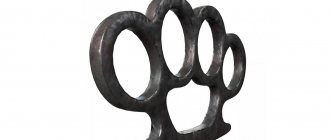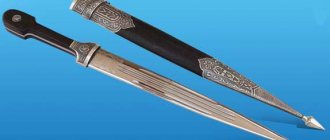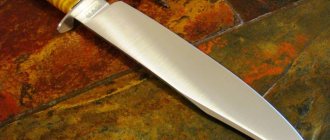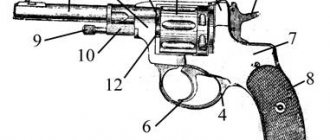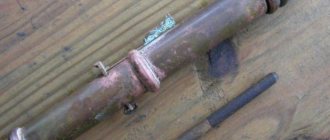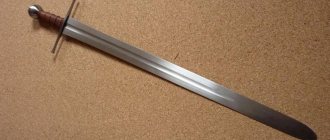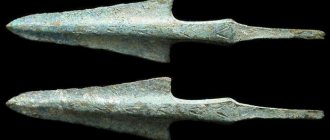The pike is a polearm weapon that is essentially a long spear, widely used by infantry. Unlike many similar types of weapons, the pike was not intended to be thrown. Pikes were regularly used in warfare in Europe from the early Middle Ages until about 1700, armed with foot soldiers for close combat. This type of weapon found wide use in the armies of the Landsknechts and the Swiss mercenaries, who used it as the main weapon in the battle formation. A similar weapon called the sarisa was also used very effectively by the phalanx infantry of Alexander the Great. In general, a regular spear can be considered a pike when it is too long to be wielded in combat with one hand.
Design
The pike is a long weapon; the shaft dimensions varied from 3 to 7.5 meters. The weight of such weapons ranged from approximately 2.5 to 6 kg. The sixteenth-century military writer Sir John Smith described the advantages of lighter types of pikes over heavier ones. In appearance it was a wooden shaft, edged with an iron or steel tip. The area in front of the point was often reinforced with metal strips called “cheeks” or splints. When troops from both opposing armies used a pike in battle, it often degenerated into a sort of arms race in which they tried to use a longer shaft and tip so that one side's pikemen could have an advantage in the fight. The extreme length of such a weapon required the shaft to be made from very strong wood, such as ash, with the shaft thinned slightly towards the point to prevent sagging at the ends, although this was always a problem when using a pike. Calling spears with a wide blade at the tips pikes is a common mistake; these types of weapons have their own separate names: halberd, glaive or vulge.
The long length of the pike made it possible to better concentrate the impact of the tip on the enemy, while the owners of this weapon found themselves at a distance unattainable from direct contact. However, such overly elongated pikes turned out to be too cumbersome in close combat. This meant that for better self-defense, for close combat, spearmen were also equipped with shorter weapons, such as a sword, mace or dagger. Basically, the spearmen tried to avoid such a disorganized battle in which they would be at a disadvantage. The position of the spearman in close combat was often aggravated by the lack of a shield, or the presence of only a small shield of limited use.
Checker
The Cossack saber is originally a North Caucasian edged weapon, which began to be widely used in the 17th-18th centuries. It is interesting to trace the history of its formation. The saber has always been an auxiliary weapon (along with a dagger or knife); only from the second half of the 19th century in Russia did the saber begin to replace sabers and broadswords, actually displacing them by the time of the First World War. And if in some units there were still other types of bladed weapons, then in the Cossack units they continued to use the pike.
Attack of the Cossacks with checkers and pikes, 1812
Source: pinterest.ru
We will not dwell in detail on chopping with a saber; for this we should write a separate article. Let’s just say that modern flanking with a saber, or even two, has little in common with the classical cutting - so that “with one blow to the fall,” from the shoulder to the saddle. This is confirmed by the story “The Duel” by A. Kuprin, in which Lieutenant Bek-Agamalov talks about chopping with a saber in the most vivid way: cutting off a horse’s neck, breaking apart a clay effigy, or chopping a stream of water so as to prevent splashing. The legendary cavalry marshal Semyon Mikhailovich Budyonny also writes in his memoirs about “terrible checker strikes,” and he, the owner of a checker strike of monstrous power, knew a lot about it.
Cossack with a pike
Source: pinterest.ru
But all this is just a shadow of the pike, because the saber was used as an independent weapon only during the Civil and Great Patriotic Wars. The rest of the time in battle, the checker was 90% an assistant to the pike.
Application tactics
The pike, due to its bulky size, was always intended to be used for defensive purposes, often in conjunction with other throwing, firearms or close combat weapons. However, more experienced troops were capable of using pikes in an aggressive attack. In each rank, pikemen were trained to position their pikes so that they would meet the enemy infantry with four or five layers of sharp points bristling from the front of the formation.
As long as the formation was maintained in this way, this formation could safely head straight towards the enemy infantry, but such a march had obvious weaknesses. The warriors in ranks moved only in the direction of travel, in one direction, and could not quickly turn around or effectively protect the vulnerable flanks, as well as the rear of the formation. It was very difficult for the huge mass of warriors wearing such bulky spears to maneuver, so movement was carried out only in the forward direction.
As a result, to protect the rear and flanks, such detachments of pikemen needed to have the support of other branches of the army, or to maneuver to contact the enemy before he could hit their weak points.
As Sir John Smith notes, there were two modes of confrontation for fighting pikemen: cautious and aggressive. The cautious approach involved fencing at the length of the pike, while the aggressive approach saw the warriors of the first five ranks quickly closing the final distance to a close-range strike, all while making a single powerful charge. The first rank of pikemen, exposed to an aggressive attack, resorted to swords and daggers if the actions of the spearmen of the first five ranks failed to break the opposing attack. Smith thought the cautious approach was ridiculous.
Also, being primarily a military weapon, the pike could be surprisingly effective in individual fights. Many 16th-century sources explain how the advantage of this type of weapon could be used by participants in a duel. Fencers of that time often practiced duels with each other using long sticks instead of pikes. George Silver considered the 5 meter pike one of the most advantageous weapons for open combat, as it gave him superiority over all other weapons shorter than 2.5 meters or sword and dagger/shield combinations.
Halberd, or "long knife of the Vatican"
That’s exactly what the Saracens called the “long knife of the Vatican,” according to the testimonies of participants in the crusades (and they are preserved in the library of the papal state to this day), a hybrid of a spear and a battle axe.
And here we step on the thin ice of contradiction. Fans of bladed weapons cannot agree on whether to consider a halberd a spear or an ax on a long shaft. However, this is probably the fate of any successfully designed weapon. Take, for example, a Kalashnikov assault rifle: should we consider it a submachine gun or an assault rifle? There are no, no, disputes about this, and they do arise among gunsmiths. Same with the halberd. But if the spear is currently used only by rare lovers of tickling their nerves while hunting, then the halberd is in service to this day.
Of course, “long knives” in the hands of the Vatican army - the Swiss Guards - now look like a kind of anachronism, but tradition is tradition. And it seems that if such a need arises, the halberdiers in blue and gold uniforms will cause no less a stir than their ancestors, who once went to liberate the Holy Sepulcher from the hands of infidels.
Structurally, a halberd is an ax with a tip (rarely two or more), allowing it to be used as a spear. A characteristic feature of halberds is the presence of a hook, which was convenient for pulling the rider off the horse. Judging by the images of some types of halberds (for example, Italian), it was the hook and the sharp tip that were the main combat parts of the halberd.
The chopping part was often purely symbolic, which makes it possible with a high degree of confidence to attribute the halberd to spears, and not to battle axes. However, the same participants in the crusades demolished many Saracen heads with halberds with crescent-shaped blades. It was almost impossible to dodge a blow from such an ax precisely because of its shape. Wherever the enemy moved, right or left, sharpened steel awaited him everywhere.
Should the halberd be considered the pinnacle of the evolution of piercing weapons or should it still be classified as a slashing weapon? Probably, everyone should choose the answer to this question according to their own taste.
Use of pike in ancient times
Although very long spears have been used since the beginning of organized warfare (particularly shown in works of art showing Sumerian and Minoan warriors and hunters), the earliest recorded use of a pike-like weapon in the tactical method described above is in the Macedonian sarissa used by the troops of Alexander the Great's father, Philip II of Macedon, and the subsequent dynasties that dominated the battlefields for several centuries in many countries.
After the fall of the last successor of the Macedonian line, the pike largely fell into disuse over the next 1000 years or so. One exception may have been in Germany. Tacitus recorded about Germanic tribesmen in the 2nd century AD who used "spears that were too long."
He constantly refers to the spears used by the Germans, which were "large" and "very long." Presumably he is essentially talking about the peak. Caesar, in his Notes on the Gallic War, describes the Helvetii as fighting in a dense phalanx-like formation with spears that protruded from behind their shields. Caesar was probably describing an early form of the "shield wall" formation popular in later times.
Medieval Revival
In the Middle Ages, the main formations that used pikes were urban militias, such as the Flemings or the peasants of the Scottish plains. For example, the Scots used a formation known as a schiltron in several battles during the Scottish War, including the Battle of Bannockburn in 1314. The Flemings also used their long spear "gelbon" to stop the attack of French knights at the Battle of Courtrai in 1302, before other troops of the Flemish army counterattacked the stalled heavy cavalry with godendags.
Both battles were noted by contemporaries as an excellent example of the triumph of commoners over superbly equipped professional warriors. The victory was achieved through the competent use of pikes and the brave resistance of the commoners who fought with them.
These formations were essentially invulnerable to the attacks of mounted warriors, as long as the knights "obediently" threw themselves against the walls of the spears, and the foot soldiers remained strong in spirit under the constant pressure of the cavalry charge. However, the dense structure of the ranks of pikemen remained vulnerable to enemy archers and crossbowmen, who could fire at them with impunity, especially if they did not have specialized armor. Many defeats, such as at the Battle of Roosebeek and the Battle of Halidon Hill, were suffered by militia pikemen armies when faced with more calculating opponents who hired archers and crossbowmen to thin out the ranks of blocking pikemen before the squadron engaged them.
Medieval pike units tended to have greater success when they operated in an aggressive manner. The Scots at the Battle of Stirling Bridge (1297), for example, used the momentum of their attack to defeat the English army while the English were crossing the narrow bridge. At the Battle of Laupen (1339), the Bernese spearmen overwhelmed the infantry forces of the opposing Habsburg/Burgundian army with a massive blow that allowed them to defeat the Austro-Burgundian horsemen. At the same time, such aggressive actions required significant tactical cohesion or suitable terrain to be able to protect the vulnerable flanks of the pikemen, especially from attacks by mounted horsemen. When support units were unable to adequately cover their flanks, the pikemen often suffered serious casualties, examples being the Battle of Mons-en-Pevele (1304), the Battle of Cassle (1328), the Battle of Roosebeke and the Battle of Roosebeke. (1382) and the Battle of Opha (1408). The continued success of the Swiss mercenaries in the later period is due to their strict discipline and tactical unity, due to their semi-professional nature, due to which the lateral protection of the allied units made it possible to somewhat mitigate the threat from flank attacks.
Often, the pikemen's units, using an aggressive style of fighting, were made up of dismounted knights, as for example at the Battle of Sempach (1386), where the dismounted Austrian vanguard, using their spears as pikes, initially successfully fought against Swiss opponents armed with halberds. Dismounted Italian warriors also used a similar method to defeat the Swiss at the Battle of Arbedo (1422). Well-armed Scottish nobles (who were even aided by King James IV) were described as leading the ranks of the Scottish pikemen at the Battle of Flodden, making the entire force resistant to English bow fire.
The rise of the Renaissance
The Swiss solved the initial problems of using the pike and brought the use of this weapon to the Renaissance in the 15th century, established clear regimes and procedures for training in the use of the pike in order to provide the army with masters of the use of the so-called. "Spiess" (German term for "spit") in maneuvers and combat; they also introduced marching to drums for this purpose. This practice also meant that detachments of pikemen could carry out serious attacking actions, in addition to defensive combat, which reduced passivity and added aggressiveness in battle. However, at the same time, the pikemen were well trained in defensive combat in case of a cavalry attack. German soldiers, known as Landsknechts, later adopted pike techniques from the Swiss. The Scots preferred to use shorter spears in their schiltron formation; their attempt at using the longer "continental" pike was reduced to a generally rare use after the weapon's ineffective use resulted in a humiliating defeat at the Battle of Flodden. The Swiss phalanxes of the Landsknechts also included soldiers armed with two-handed swords, zweihanders, and halberdiers, to more effectively repel infantry and cavalry attacks in close combat.
The Swiss faced Landsknechts, who used similar tactics to the Swiss themselves, but with more pikes and in a more complex "deutschen Stoss" formation (the pike was held with both hands in the lower third of its length), allowing for a more flexible attack column.
The good military reputation of the Swiss pikemen and landsknechts subsequently led to the employment of these mercenary units in armies throughout Europe so that other armies could learn similar combat tactics. These types of units, as well as others who adopted similar tactics, were able to fight in several wars, resulting in a series of unique events.
These formations had great successes on the battlefield, starting with the brilliant victories of the Swiss cantons against Charles the Bold of Burgundy, during the Burgundian Wars, in which the Swiss participated in 1476 and 1477. In the battles of Granson, Murten and Nancy, the Swiss not only successfully repelled the attacks of enemy knights, since the Scottish and Flemish infantry units fought relatively passively, which was a characteristic feature of the early Middle Ages, but even went on the attack with great zeal. Their attacks in columns fought through the Burgundian forces, sometimes causing great massacres.
Columns attacking with pikes remained the primary form of effective infantry warfare for the next forty years. The Swabian War was the first conflict in which both sides had large formations of well-trained pikemen. After that war, its combatants - the Swiss (later, usually serving as mercenaries) and their "imitators" Landsknechts - often met during the Italian wars, which became in many ways a military testing ground for the Renaissance.
In Japan at that time there was a parallel evolution of polearms. The Japanese style of warfare, however, was much more fast-paced and aggressive, using smaller formations, than its European counterparts. The naginata and yari became common weapons for Japanese ashigaru infantrymen (who used extremely long yari) who dismounted the samurai due to the weapon's greater reach compared to the swords carried by the samurai. The naginata came into use around 750 AD. This weapon had a curved, sword-like blade on a wooden pole; on the back of the spear there was a metal counterweight, often with a point, for piercing blows. The use of such a device caused the forced introduction of greaves for riders, since effective cavalry fighting was very important. The length of the yari spears varied. They had a straight blade, usually with pointed blades, and sometimes with projections from the central blade, secured in the recess of the shaft with a very long tang. Around the later half of the 16th century, pikemen holding pikes 4.5 - 6.5 meters long, sometimes even up to 10 meters, became the main forces of armies. They formed lines united with warriors armed with arquebuses and spearmen using shorter spears. The pikemen formed two or three lines of defense and raised and lowered their spears according to incoming orders.
As a result, the development of firearms and artillery in the 16th century left large formations consisting entirely of pikemen vulnerable to fire, despite their amazing power in close combat. Significant losses in pike columns were evident in the bloody Battle of Biocca in 1522, where arquebus-wielding warriors inflicted a heavy defeat on Swiss pike forces.
Sovnya
Imagine a curved blade on a very long handle - and you will get an idea of this weapon. The owl could deliver not only piercing, but also slashing blows. The latter, presumably, were rarely used, and this was justified for two reasons. Firstly, in a close formation you couldn’t swing such a thing without the risk of hitting your own people, and secondly, the owl had significant inertia, which made it difficult to handle.
However, one skilled warrior with an owl, finding himself surrounded by enemy swordsmen or even spearmen, could relatively easily maintain a zone around him “free from passersby.” Only an archer or a crossbowman could defeat him.
A glaive can be considered similar to an owl. This weapon is structurally very similar to the owl, but is much more famous. The glaive was especially popular during the Venetian Republic. The guards of the local doges were armed with these weapons, but reliable information about their combat use has not survived to this day - unlike samples of the weapons themselves, which were decorated with gilding and etched patterns. Therefore, many fans of polearms believe that glaives were only ceremonial weapons, designed to emphasize the position of the doge in society. In general, something like the hatchets made of pure silver, which were armed with the guards of John IV, known in history as the Terrible. But the development of the spear did not stop there. Its further evolution led to the emergence of such an object as
Pike and small arms
In the aftermath of the Italian Wars from the late 15th to late 16th centuries, most European armies switched to using pikes, often in combination with primitive firearms such as arquebuses. Large defensive detachments of pikemen were formed, behind which the riflemen could hide.
A typical example of such development were the Spanish tercios (formations), which consisted of: a large formation of pikemen; small, mobile squadrons of arquebusiers moving around the perimeter; as well as traditional vigilantes. These three elements formed a mutually supportive combination of tactical roles: arquebus-armed warriors harassed the enemy line, pikemen defended arquebus-armed warriors from enemy cavalry attacks, and vigilantes, typically armed with swords and spears, charged enemy pikemen units if two such opposing formations engaged in contact. The Tertii fielded fewer spearmen than the Swiss mercenary and Landsknecht columns, and their formations ultimately proved much more tactically flexible on the battlefield.
Mixed military formations quickly became the norm for European infantry. They tried to imitate the thirds in England. A combination of halberdiers, longbowmen and vigilantes became the norm, although this arrangement changed when the island's yew supply dried up.
The percentage of warriors who were armed with firearms in formations like the Tertia constantly increased as technology in the production of firearms advanced greatly. This progress is believed to be a consequence of the decline of the cavalry, although in fact it restored it. Although cheaper and more versatile infantry became increasingly adept at using firearms, the proportion of cavalry in armies remained quite high. In the late sixteenth and early seventeenth centuries, smaller formations of pikemen were used to protect the musketeers, often as a central detachment with two squads of skirmishers on either side, called "shot arms".
During this period, the length of the peak, as a rule, was from 4.5 to 5.5 m. There are, however, sources that insist on slightly different sizes of the peak - from 3 to 4.5 meters.
